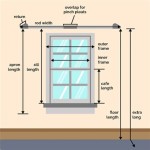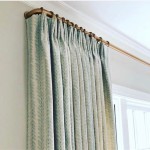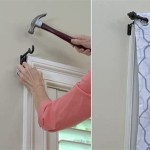How to Hang Temporary Curtains
Temporary curtains offer a practical and cost-effective solution for various needs, including privacy enhancement, light control, space division, or aesthetic improvements in rental properties, dorm rooms, temporary housing, or even for special events. Unlike permanent installations involving drilling and complex hardware, hanging temporary curtains focuses on utilizing methods that are easily reversible, damage-free, and adaptable to different window sizes and types. This article provides a comprehensive guide on successfully hanging temporary curtains using various techniques and materials.
Before embarking on the installation, careful planning is essential. This involves assessing the specific needs the curtains will fulfill, evaluating the window or space where they will be installed, and selecting the appropriate materials and hanging method. Failure to adequately plan can lead to unsatisfactory results or even damage to the surrounding surfaces.
Assessing Needs and Choosing the Right Materials
The first step is to determine the primary purpose of the temporary curtains. Are they intended for privacy, light blocking, sound dampening, or purely for decorative purposes? The answer to this question will significantly influence the type of fabric chosen. For instance, if privacy is the primary concern, heavier, opaque fabrics are preferable. If light control is the goal, blackout liners or thick, tightly woven materials are recommended. For purely aesthetic purposes, lighter, more decorative fabrics can be used.
Once the purpose is defined, consider the environment where the curtains will be hung. In a humid environment, mildew-resistant fabrics are crucial. In a space with children or pets, durable, easy-to-clean fabrics are desirable. The size and weight of the fabric also matter. Heavier fabrics require stronger support systems, while lighter fabrics can be easily accommodated by less robust methods.
Beyond the fabric, the selection of hanging materials is equally important. Commonly used options include tension rods, adhesive hooks, command strips, and even alternatives like wire or rope. The choice depends on the weight of the fabric, the surface to which the curtains will be attached, and the desired aesthetic. Tension rods are ideal for fitting inside window frames without any drilling, while adhesive hooks offer versatility for hanging curtains from a variety of surfaces. Command strips, known for their damage-free removal, are suitable for lighter fabrics. It's vital to accurately measure the window dimensions and calculate the required fabric length and width, adding extra inches for hemming and gathering, if desired.
Exploring Different Hanging Methods
Several methods exist for hanging temporary curtains, each with its own set of advantages and disadvantages. Understanding these options allows for selecting the most appropriate method based on specific circumstances and preferences. The key is to prioritize methods that are non-permanent and minimize potential damage to walls or window frames.
Tension Rods: Tension rods are a popular choice for temporary curtain hanging due to their ease of installation and damage-free nature. These rods rely on spring tension to stay in place within the window frame, eliminating the need for drilling or screws. To install, simply extend the rod slightly beyond the window frame width, compress the spring, and fit the rod into place. Ensure the rod is level and securely positioned to prevent it from slipping. Tension rods are best suited for lightweight to medium-weight fabrics and are available in various lengths and finishes. The primary limitation is the weight capacity; extremely heavy fabrics may cause the rod to lose tension and fall.
Adhesive Hooks: Adhesive hooks, such as those from Command brand, offer a versatile solution for hanging curtains from a variety of surfaces, including walls, window frames, and even ceilings. These hooks utilize adhesive strips that provide a strong hold while allowing for damage-free removal. Before installation, thoroughly clean the surface with rubbing alcohol to ensure proper adhesion. Apply the adhesive strip to the hook and firmly press it onto the surface, holding it in place for the recommended duration (typically 30 seconds). Allow the adhesive to cure for the specified time (usually an hour) before hanging the curtains. Adhesive hooks are available in different sizes and weight capacities, so choosing the appropriate hook for the curtain's weight is critical. They are ideal for lightweight to medium-weight fabrics and provide a clean, minimalist look.
Loop and Hook Tape: Using loop and hook tape, also known as Velcro, is a flexible option for attaching curtains directly to a window frame or wall. One side of the tape (the loop side) is attached to the back of the curtain, while the other side (the hook side) is attached to the desired surface. This method requires careful alignment to ensure the curtain hangs straight. The hook side can be attached using adhesive strips or, for a more secure hold, with small, easily removable tacks or staples. This method works well for lightweight fabrics and allows for easy removal and reattachment of the curtains for cleaning or adjustments.
Wire or Rope: For a more rustic or unconventional look, wire or rope can be used to hang curtains. This method involves creating a simple loop or line across the window frame and attaching the curtains using clips or loops. The wire or rope can be secured to the frame using adhesive hooks or by tying it to existing fixtures. This method is best suited for lightweight fabrics and adds a unique aesthetic to the space.
No-Sew Methods: Several no-sew methods exist for creating temporary curtains, further simplifying the installation process. Hemming tape, also known as fusible tape, allows for creating hems and seams without sewing. Simply fold over the edge of the fabric and apply the hemming tape between the layers, then iron it to fuse the fabric together. Another option is to use fabric glue or a hot glue gun to create hems and attach embellishments. These methods eliminate the need for sewing skills and allow for quick and easy customization of the curtains.
Ensuring Proper Installation and Maintenance
Regardless of the chosen hanging method, proper installation is crucial for ensuring the curtains hang correctly and securely. Start by accurately measuring the window or space where the curtains will be installed. This will determine the required fabric length and width, as well as the placement of the hanging hardware. Use a level to ensure the curtains hang straight and even. Uneven curtains can detract from the overall aesthetic and may indicate an improperly installed support system.
Before hanging the curtains, inspect the fabric for any imperfections, such as snags or stains. Iron or steam the fabric to remove wrinkles and creases. When attaching the curtains to the hanging hardware, ensure they are evenly distributed to prevent sagging or uneven weight distribution. If using clips or loops, space them evenly along the top of the curtain to ensure a uniform look.
Regular maintenance is essential for keeping the temporary curtains looking their best. Dust or vacuum the curtains regularly to remove accumulated dirt and debris. Spot clean any stains or spills immediately with a mild detergent and a soft cloth. If the curtains are machine washable, follow the manufacturer's instructions carefully to prevent damage. Avoid using harsh chemicals or bleach, as these can damage the fabric and cause discoloration.
Periodically inspect the hanging hardware for any signs of wear or damage. Replace any worn or broken adhesive strips or hooks to prevent the curtains from falling. Adjust the tension rods as needed to maintain a secure fit. By following these simple maintenance tips, the temporary curtains can provide years of reliable service and enhance the aesthetic appeal of the space.
When it's time to remove the temporary curtains, do so carefully to avoid damaging the walls or window frames. If using adhesive hooks or Command strips, follow the manufacturer's instructions for removal. Gently peel the adhesive strip away from the surface, pulling it straight down to prevent tearing or leaving residue. If using tension rods, carefully compress the spring and remove the rod from the window frame. Clean any remaining residue with a mild cleaner and a soft cloth. Store the curtains in a clean, dry place to prevent damage or mildew. By following these guidelines, hanging temporary curtains proves to be a straightforward, adaptable, and damage-free solution for enhancing any living space.

Inexpensive Temporary Window Coverings

5 Easy Ways To Hang Curtains Without Drilling

How To Hang Curtains Without Drilling

Inexpensive Temporary Window Coverings

Easy Ways To Hang Curtains For Temporary Homes

Diy Curtains World S Easiest Artbar
Creative Diy Ways For Hanging Curtains Without Rods

6 Ways To Hang Sheer Curtains Deconovo Us

6 Ways To Hang Sheer Curtains Deconovo Us

Inexpensive Temporary Window Coverings








